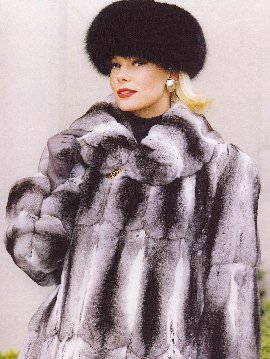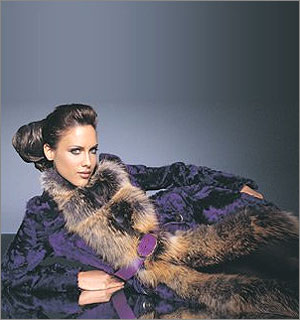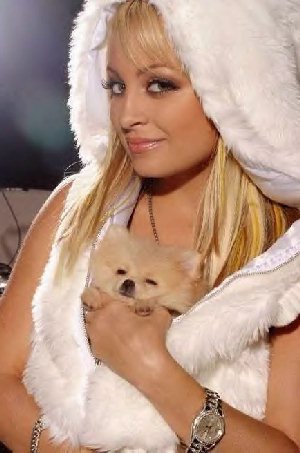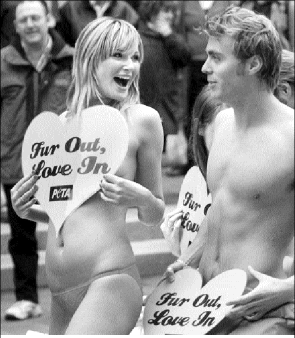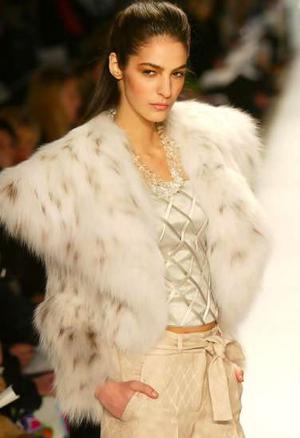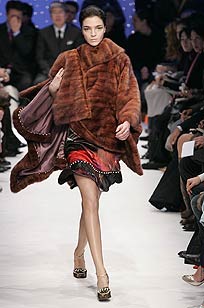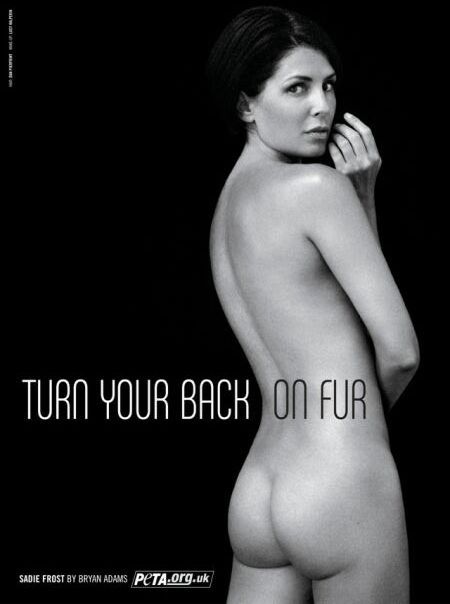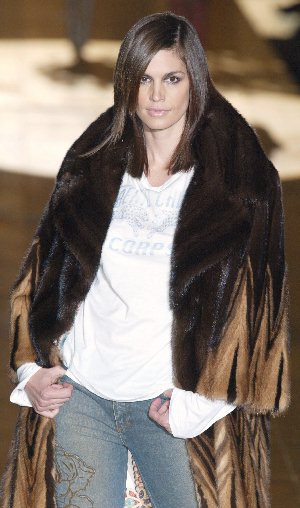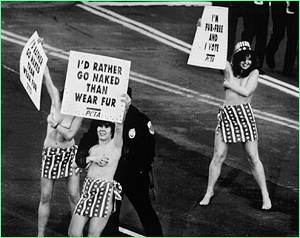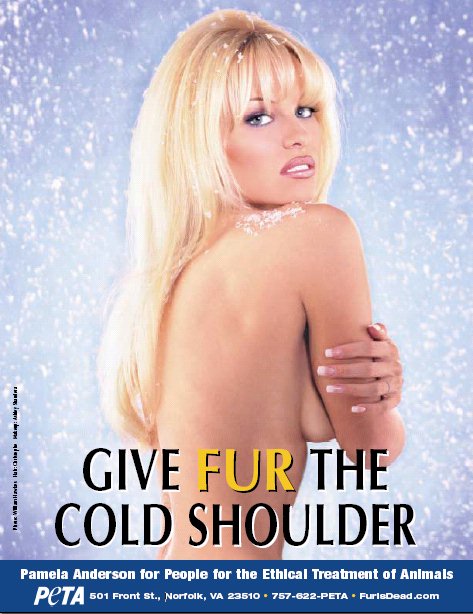| Is Fur Dead?
The Fashion eZine - Fashion Vs Anti-Fur
Is Fur Dead? Fashion Vs Anti-Fur
See also Sustainable Fashion Many years ago I worked in a chinchilla factory owned by my parents. I swept floors, cleaned cages, fed and watered chinchillas that would eventually be destined to make fur coats. Chinchilla fur is considered to be the softest and most luxurious fur money can buy, and thus is pretty expensive. My parents eventually got out of the fur business when the market bottomed out due to anti-fur protestors. My parents were bankrupt. So I'm coming from a rather unique position on the fur trade, having taken part in the raising of said animals. BTW, Chinchillas bite. But bites or no bites, I myself am a bit of a fence sitter on the whole anti-fur issue. I really don't care if people wear fur. Cavemen wore fur, so to me fur is very natural. Its really the only fabric humans are meant to wear. On the other hand, humans have also evolved to a level where we don't need to wear fur any more. We have hundreds of fabrics to choose from. I could even foresee a future in which clothing in general is mostly unnecessary and society converts to naturalism. But it isn't going to happen now or for a very long time.
I'm not so much worried about the whole cruelty to animals issue either. We humans are cruel to everything, including each other. We have far more pressing concerns like war and the environment to worry about. In other words, anti-fur really isn't that big of a concern and doesn't deserve much attention. Unless of course people are hunting nearly extinct or endangered species. IE. Polar bears are now endangered, and thus should be strictly off limits to the fur trade. But other non-endangered creatures such as rabbits (which multiply by the thousands) I don't really mind if people wear it. In general wearing fur is immoral these days, but we do need to keep the rabbit population down. Its really a lifestyle choice and question of whether you want people thinking of you as a heartless bitch who cares more about fashion than you do about animals.
Dennis Rodman Naked in Fashion Week Blitz
Dennis Rodman is coming to NYC for Fashion Week—not to sit in the front row at a show, but to unveil his provocative new PETA ad in the very tents where designers are pushing fur. In PETA’s ad, Rodman appears nude—except for his tattoos—alongside the caption, “Think Ink, Not Mink,” and urges: “Be comfortable in your own skin and let animals keep theirs.” Rodman is the first man—and the first sports star—to pose for PETA’s “Rather Go Naked Than Wear Fur” series, which has featured Pamela Anderson, Kim Basinger, and Christy Turlington. When the 6’8” basketball legend, whose own “Dennis Rodman Foundation” helps the homeless, heard about PETA’s program that donates thousands of castoff fur coats to homeless shelters across the country, he instantly agreed to pose for the cause, explaining that furriers have pushed free furs on him over the years and he’s always refused to take them—he only wears fake fur. Rodman watched Pamela Anderson's three-minute video showing how animals live and die before being made into fur coats. “If you actually look at [the video] firsthand, it gives you a different perspective on animals and how they’re treated. … It’s heart-wrenching to see what they go through,” he said. Check out the exclusive behind-the-scenes footage of Rodman’s PETA photo shoot with fashion photographer Ian Brooks at L.A.’s famed Smashbox Studios. Rodman’s makeup was done by Autumn Moultrie, his hair by Tanya Stine. 
Paris Hilton Ambushed by an Anti-fur Activist
The socialite and designer Julien MacDonald were pelted with flour when going to his late-night party after a London Fashion show Paris Hilton is once again in the spotlight, but this time, the sexy socialite has become the latest target for animal rights group People For the Ethical Treatment of Animals (PETA). “The Simple Life” star was slammed by an anti-fur activist last night as she was on her way to an after-show party, following her catwalk appearance for Julien MacDonald presenting his collection at London Fashion Week show. In fact, PETA representatives were out there to ambush designer MacDonald, and not Paris, for his "relentless use of fur." The designer draped a baby fox fur around Jade Jagger’s neck in a show last autumn, causing a lot of angry replies from the animals’ protectors. The designer and the socialite star were pelted with flour when going to his late-night party, in order to be punished by the PETA people. "Julien MacDonald may have been able to ignore images of bloody skinned animals gasping for breath in the past, but hopefully a dash of flour will help him rise to the occasion and forsake fur once and for all," Yvonne Taylor, the representative of PETA Europe stated.
Sophie Ellis Bextor hits out at fur fashion
Sophie Ellis Bextor has backed a campaign attacking people who wear fur. The pop singer has posed for a new hard-hitting poster which shows her wearing a stunning black dress and holding up a skinned fox. Underneath her picture are the words: 'Here's the rest of your fur coat'.
Fur is making a bit of a comeback on the catwalk: It'll be put up on billboards and in magazines all around the world by anti-fur group, People for the Ethical Treatment of Animals (Peta). Sophie, who used to be a model, said: "I think fur is really pathetic when there are so many alternatives. "To me it felt a very natural thing to do, to be on the side of animals when it came to fur." Anti-fur campaigners are worried that fur is making a comeback in the fashion world. For years it's been considered unacceptable, but fur's been seen on the catwalk and in some fashion magazines over the last couple of years.
|
|
|
McCartney backs anti-fur fashion
LONDON, England (CNN) -- The revival of fur on the catwalks for winter 2002 shows that animal rights activists are having difficulty converting the fashion industry. But they have a strong advocate in British designer Stella McCartney. McCartney opened her first store in Manhattan's meatpacking district -- an odd choice for such a well-known animal rights campaigner. Her compassion towards animals is reflected in her work, which avoids not only fur, but all animal products. "Everything in [my] store and every single garment and accessories that you see is cruelty free in the sense no animal has died to make anything in here," she said. "I just think that a lot of people out there don't want products that an animal has had to die for." While she appreciates the beauty of fur, she prefers "to feel it on a living creature than as a dead piece of fabric." McCartney's late mother, Linda, was also an animal activist, and produced a vegetarian food range.
Stella McCartney's views are similar to French actress Brigitte Bardot, once often photographed in fur but now a strident animal advocate. "When I used to wear fur I didn't realise what I was wearing. It was beautiful and I didn't think about it. I didn't think about the suffering, torture and death that were behind it. "Once I realised, I refused to ever wear a fur again," said the former sex symbol. Bardot has spent the past few decades persuading governments that animals have rights too. "We don't need fur to survive. We don't live in caves any more. We have central heating, air conditioning, carpets, cosy flats. "I don't understand how we can kill -- raise first and then kill -- just for a superficial luxury. They are inncocent yet condemned to gas chambers. They way in which we kill them is terrifying." Karl Lagerfeld, who used fur extensively in his winter 2002 collection defends the practice: "It should be handled in the nicest way but as long as we eat meat and wear leather, I don't even think there is a subject to discuss." But fur's revival this season demonstrates that the animal right message is facing difficulty getting through to fashion industry. Even McCartney's impact is limited. Her label is 50 percent owned by Gucci which profits from selling leather handbag -- a fabric McCartney is against. Yet she sees her stance as a positive step for activists. "I'm a firm believer in infiltrating from within really," McCartney said.
The Fur Factor
Kate Moss flaunts her designer furs: former best friend Sadie Frost strips naked to campaign against it. Hadley Freeman reports on the fightback against fashion's passion for fur. In a self-consciously retro ice-cream parlour in north London, designer Sadie Frost, clad in a simple chiffon dress and cardigan, ponders her new role as nude anti-fur warrior. She blushes a little when talking about a photograph taken of her for a new anti-fur campaign, saying, with a nervous tug on her cardigan: "Hopefully, people won't be too repulsed by it." Twice she makes a reference to her age (41) and children (four). Yet, when she talks about why she agreed to pose naked for the photo, taken by the singer Bryan Adams, she loses all self-deprecation: "For me, it was a positive message about my anti-fur beliefs. It wasn't for FHM, or whatever, but something I believe in strongly and, hopefully, people will take notice." Frost, a lifelong vegetarian, is the latest celebrity to lend support to the anti-fur pressure group Peta (People for the Ethical Treatment of Animals). "I've really noticed fur coming back in the past five years," says Frost, "and it has been getting more and more outrageous. I have never understood its appeal. It makes me think of blood, guts, cages." There is little doubt that fur is back. The facts about it have not changed since it fell from favour in the '90s, but people's attitudes apparently have. The International Fur Trade Federation reported last year that sales of fur globally rose from $US9.1billion ($A12.04 billion) in 2000 to $US11.7bn ($A15.49 billion) in 2004.
Anti-fur campaigners insist they are still winning the war but, even aside from the undeniable financial facts, one look at the fashion catwalks - and audiences - tells a different story. Even garments that one would have thought were impossible to make furry have been coated in pelts. Burberry has swathed its traditional trench coats in fur; Prada, in perhaps the most gratuitous use of fur this side of Louis Vuitton's logoed rabbit-fur earmuffs, fringed the soles of its platform shoes with it. The most flagrant use of fur on the catwalk recently, though, was at Jean Paul Gaultier's couture show in July, when a model came down the catwalk in a fur coat, replete with multiple fox heads bobbing along the sides. "Designers have often courted controversy, and using fur does provoke outrage and column inches, but it does not get public support," insists Peta's vice-president, Dan Mathews.
This isn't wholly true. In the past few years, fur has become so common on the catwalk that it causes no more interest than a particularly high heel. This shift back to fur may seem remarkable, but it was fairly predictable. Just a decade ago, supermodels strode across Peta's adverts, proudly declaring their preference for nudity over fur. Not wearing it was the trendy position, and that is precisely the problem: when a trend becomes too popular, the backlash can only be a matter of time. In other words, the anti-fur movement was a victim of its own success. Like cheekily rebellious teenagers, today's celebrities, such as Jade Jagger and Moss, frequently wear fur - which both excites the paparazzi and emphasises that they are far more interested in style than in being granola-munching animal-rights campaigners. There is also something of the nose-thumbing adolescent in some of the comments by pro-fur celebrities and designers. Backstage after his fur-heavy show last year, which opened with Elizabeth Jagger wearing a fox stole, Julien Macdonald grinned: "I adore fur. It adds ultimate luxury and glamour to my collections." Not everyone, however, is quite as comfortable with expressing their love of fur. Few designers contacted for this article were willing to comment. Burberry issued the nervy statement:
"As a luxury brand, there will be occasions where the use of fur will be considered important to the design and aesthetics of a product. In those instances we will continue to use fur. However, we will not use fur if there is a serious concern that the fur has been produced by the unacceptable treatment of the animals concerned." Not a single fashion editor of even the most fur-happy magazine on either side of the Atlantic was willing to express a comment, either for or against fur, on the record. The most telling sign of the fashion world's shifting attitude to fur (or perhaps of the sheer emptiness of the earlier anti-fur rhetoric) came from two of Peta's famous faces in the '90s, Naomi Campbell and Cindy Crawford. Campbell was photographed not long after wearing a fur coat while, in 2004, Crawford actually fronted a fur company's advertising campaign. Crawford dismissed Peta's reprimands via her publicist, saying that she had never really supported Peta's stand against fur, but was, instead, being "really nice" to the organisation when she posed for its campaign in the '90s. The anti-fur position still has its fair share of celebrity supporters, such as Pamela Anderson and Charlize Theron. But, as more actresses, models and pop stars have started to wear fur, an interesting, not to mention enjoyable, situation has arisen in which celebrities have started to snipe at each other's beliefs. Heather Mills McCartney, for example, recently stormed Jennifer Lopez's studio to protest against Lopez's fondness for fur in her wardrobe and her fashion range. Indeed, it is hard not to read veiled references to her best friend Moss in some of Frost's comments. "I think a lot of the time in this world you're surrounded by this kind of whirlwind when you're an actor or in a band or a model," she says. "It's very hard to remember who you are and your beliefs when you're told, 'Put this on', 'Put that on'. But they're not thinking about what they're doing, what message they're giving to other people. They're all so involved in how they look, what their skin's like, what their hair's like, how glamorous they are. "Surely they should be thinking about something a little deeper than that? To me, it shows someone to be a little shallow." The return to fur in fashion came also from a wider change in attitudes. In the '90s, the trend was for anti-ostentation, such as grunge, or Calvin Klein-style minimalism. The early 21st century, however, has been dominated by the bling-bling look, with rappers singing about their love of champagne and piling on the diamonds. We have returned to the '80s, when it was perfectly acceptable to flaunt one's wealth through one's outfit - and nothing flashes the cash quicker than a big ol' fur. It's hard to know how to turn the tide or, to put it another way, who bears the greatest responsibility - designers, celebrities or customers. "It's all three together," says Frost. "Designers will keep designing it if the public want it; the public will keep buying it if the fashion icons are wearing it; and the fashion icons wear it because the designers make it. It's hard to know where to start."
 | |
